Memory card
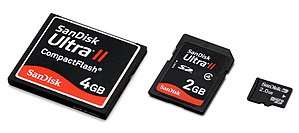
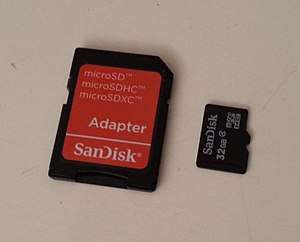
A memory card, flash card or memory cartridge is an electronic flash memory data storage device used for storing digital information. These are commonly used in portable electronic devices, such as digital cameras, mobile phones, laptop computers, tablets, PDAs, portable media players, video game consoles, synthesizers, electronic keyboards, and digital pianos.
History
PC Cards (PCMCIA) were the first commercial memory card formats (type I cards) to come out, but are now mainly used in industrial applications and to connect I/O devices such as modems. Since 1994, a number of memory card formats smaller than the PC Card arrived, the first one was CompactFlash and later SmartMedia and Miniature Card. The desire for smaller cards for cell-phones, PDAs, and compact digital cameras drove a trend that left the previous generation of "compact" cards looking big. In digital cameras SmartMedia and CompactFlash had been very successful. In 2001, SM alone captured 50% of the digital camera market and CF had captured the professional digital camera market. By 2005 however, SD/MMC had nearly taken over SmartMedia's spot, though not to the same level and with stiff competition coming from Memory Stick variants, as well CompactFlash. In industrial and embedded fields, even the venerable PC card (PCMCIA) memory cards still manage to maintain a niche, while in mobile phones and PDAs, the memory card has become smaller.
Since 2010, new products of Sony (previously only using Memory Stick) and Olympus (previously only using XD-Card) have been offered with an additional SD-Card slot.[1] Effectively the format war has turned in SD-Card's favor.[2][3][4]
Data table of selected memory card formats
| Name | Abbreviation | Form factor | DRM |
|---|---|---|---|
| PC Card | PCMCIA | 85.6 × 54 × 3.3 mm | No |
| CompactFlash I | CF-I | 43 × 36 × 3.3 mm | No |
| CompactFlash II | CF-II | 43 × 36 × 5.5 mm | No |
| CFexpress | CFX | 38.5 × 29.8 × 3.8 mm | Unknown |
| SmartMedia | SM / SMC | 45 × 37 × 0.76 mm | No |
| Memory Stick | MS | 50.0 × 21.5 × 2.8 mm | MagicGate |
| Memory Stick Duo | MSD | 31.0 × 20.0 × 1.6 mm | MagicGate |
| Memory Stick PRO Duo | MSPD | 31.0 × 20.0 × 1.6 mm | MagicGate |
| Memory Stick PRO-HG Duo | MSPDX | 31.0 × 20.0 × 1.6 mm | MagicGate |
| Memory Stick Micro M2 | M2 | 15.0 × 12.5 × 1.2 mm | MagicGate |
| Miniature Card | 37 × 45 × 3.5 mm | No | |
| Multimedia Card | MMC | 32 × 24 × 1.5 mm | No |
| Reduced Size Multimedia Card | RS-MMC | 16 × 24 × 1.5 mm | No |
| MMCmicro Card | MMCmicro | 12 × 14 × 1.1 mm | No |
| P2 card | P2 | No | |
| Secure Digital card | SD | 32 × 24 × 2.1 mm | CPRM |
| SxS | SxS | No | |
| Universal Flash Storage | UFS | Unknown | |
| miniSD card | miniSD | 21.5 × 20 × 1.4 mm | CPRM |
| microSD card | microSD | 15 × 11 × 0.7 mm | CPRM |
| xD-Picture Card | xD | 20 × 25 × 1.7 mm | No |
| Intelligent Stick | iStick | 24 × 18 × 2.8 mm | No |
| Serial Flash Module | SFM | 45 × 15 mm | No |
| µ card | µcard | 32 × 24 × 1 mm | Unknown |
| NT Card | NT NT+ | 44 × 24 × 2.5 mm | No |
| XQD card | XQD | 38.5 × 29.8 × 3.8 mm | Unknown |
- Secure Digital card (SD)
 MiniSD Card with an SD card adapter
MiniSD Card with an SD card adapter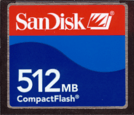 CompactFlash (CF-I)
CompactFlash (CF-I)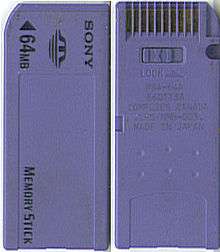
 MultiMediaCard (MMC)
MultiMediaCard (MMC)

Overview of all memory card types
- PCMCIA ATA Type I Card (PC Card ATA Type I)
- PCMCIA Type II, Type III cards
- CompactFlash Card (Type I), CompactFlash High-Speed
- CompactFlash Type II, CF+(CF2.0), CF3.0
- Microdrive
- CFexpress
- MiniCard (Miniature Card) (max 64 MB / 64 MiB)
- SmartMedia Card (SSFDC) (max 128 MB) (3.3 V,5 V)
- xD-Picture Card, xD-Picture Card Type M
- Memory Stick, MagicGate Memory Stick (max 128 MB); Memory Stick Select, MagicGate Memory Stick Select ("Select" means: 2x128 MB with A/B switch)
- SecureMMC
- Secure Digital (SD Card), Secure Digital High-Speed, Secure Digital Plus/Xtra/etc (SD with USB connector)
- miniSD card
- microSD card (aka Transflash, T-Flash)
- SDHC
- WiFi SD Cards (SD Card With WiFi Card Built in) Powered by Device. (Eye-Fi, WiFi SD, Flash Air)
- MU-Flash (Mu-Card) (Mu-Card Alliance of OMIA)
- C-Flash
- SIM card (Subscriber Identity Module)
- Smart card (ISO/IEC 7810, ISO/IEC 7816 card standards, etc.)
- UFC (USB FlashCard) (uses USB)
- FISH Universal Transportable Memory Card Standard (uses USB)
- Intelligent Stick (iStick, a USB-based flash memory card with MMS)
- SxS (S-by-S) memory card, a new memory card specification developed by Sandisk and Sony. SxS complies to the ExpressCard industry standard.[5]
- Nexflash Winbond Serial Flash Module (SFM) cards, size range 1 mb, 2 mb and 4 mb.
Comparison
| Standard | SD | UFS Card | CFast | XQD | CFexpress | |||||||
|---|---|---|---|---|---|---|---|---|---|---|---|---|
| Version | 3.0 | 4.0 | 6.0 | 7.0[6] | 1.0 | 2.0 | 1.0 | 2.0 | 1.0 | 2.0 | 1.0 | ? |
| Launched | 2010 Q2 | 2011 Q1 | 2017 Q1 | ? | Q2 2016 | ? | 2008 Q3 | 2012 Q3 | 2011 Q4 | 2014 Q1 | 2017 Q2 | ? |
| Bus | UHS-I | UHS-II | UHS-III | PCIe | UFS 2.0 | UFS 3.0 | SATA-300 | SATA-600 | PCIe 2.0 x1 | PCIe 2.0 x2 | PCIe 3.0 x2 | PCIe 3.0 x8 |
| Speed
(full-duplex) |
104 MB/s | 156 MB/s | 624 MB/s | 1970 MB/s (?) | 600 MB/s | 1200 MB/s | 300 MB/s | 600 MB/s | 500 MB/s | 1000 MB/s | 1970 MB/s | 7880 MB/s |
Video game consoles
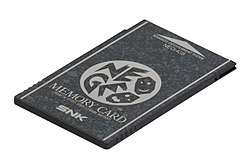
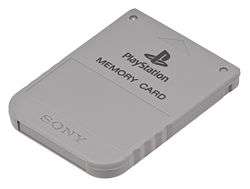
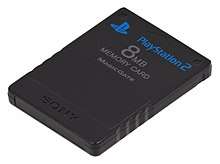
Many older video game consoles used memory cards to hold saved game data. Cartridge-based systems primarily used battery-backed volatile RAM within each individual cartridge to hold saves for that game. Cartridges without this RAM may have used a password system, or wouldn't save progress at all. The Neo Geo AES, released in 1990 by SNK, was the first video game console able to use a memory card. AES memory cards were also compatible with Neo-Geo MVS arcade cabinets, allowing players to migrate saves between home and arcade systems and vice versa.[7] Memory cards became commonplace when home consoles moved to read-only optical discs for storing the game program, beginning with systems such as the TurboGrafx-CD and Sega-CD.
Until the sixth generation of video game consoles, memory cards were based on proprietary formats; later systems have used established industry hardware formats for memory cards, such as FAT32.
Home consoles now commonly use hard disk drive storage for saved games and allow the use of generic USB flash drives or other card formats via a memory card reader to transport game saves and other game information, along with cloud storage saving, though most portable gaming systems still rely on custom memory cartridges to store program data, due to their low power consumption, smaller physical size and reduced mechanical complexity.
See also
References
| Wikimedia Commons has media related to Memory card. |
- ↑ Grunin, Lori (2010-01-06). "Sony does SD; Panasonic intros first SDXC cards | 2010 CES — CNET Blogs". Ces.cnet.com. Retrieved 2013-01-07.
- ↑ "Format-Krieg entschieden: SD-Card setzt sich durch" ("format-war resolved: SD-card prevails"), Chip-online, 14. January 2010
- ↑ "Camera trends come into focus for 2010", msnbc, 13. January.2010 "As much as the storage-format war cleared up a bit with Sony announcing that it would support SD and SDHC cards ..."
- ↑ "FEATURE: Playing Your Cards Right at Retail", Peter K. Burian, 4. June 2010. "Some industry observers have suggested that this development signals an end to the 'format war,' ..."
- ↑ "SanDisk and Sony announce SxS memory card: Digital Photography Review". Dpreview.com. Retrieved 2013-01-07.
- ↑ Pinto, Yosi. "SD + PCIe/NVMe card New Innovations in SD Cards Lead the Way to Mobile Everything" (PDF). Flash Memory Summit.
- ↑ "The Official NEO-GEO Memory Card FAQ by Billy Pitt". www.neogeoprotos.com. Retrieved 2017-02-10.
.svg.png)